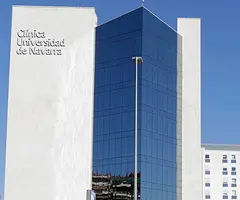Chronic myeloid leukemia
"In young patients, a bone marrow transplant can be performed if they have a donor".
DR. JOSÉ RIFÓN
SPECIALIST. HEMATOLOGY AND HEMOTHERAPY DEPARTMENT

What is chronic myeloid leukaemia?
Chronic myeloid leukaemia (CML) is a type of blood cancer that affects the bone marrow, the tissue responsible for producing blood cells. The disease causes uncontrolled growth of certain cells in the blood, especially white blood cells (leukocytes).
CML is one of the most common leukaemias in adults, accounting for approximately 15% of chronic leukaemia cases. It is usually diagnosed between the ages of 30 and 60, while it is rare in children and very old people.

A PERSONALIZED MEDICINE
Second Opinion,
peace of mind
Request a second opinion from our professionals with great experience in the diagnosis and treatment of oncological diseases
In 3 days, without leaving home.
What are the symptoms of laryngeal cancer?
Síntomas si el tumor está en la supraglotis
Los tumores en la supraglotis pueden no causar síntomas en estadios iniciales. A medida que crecen, suelen aparecer dolor al tragar (odinofagia), dolor irradiado al oído (otalgia refleja) o disfonía, si el tumor afecta a las cuerdas vocales.
Síntomas si el tumor está en la subglotis
Los tumores subglóticos pueden manifestarse como disfonía por afectación secundaria de las cuerdas vocales o por dificultad respiratoria debido a la obstrucción de la luz laringotraqueal.
Common symptoms of laryngeal cancer
- Dysphonia
- Pain on swallowing (odynophagia)
- pain radiating to the ear (reflex otalgia)
- Breathing difficulty
Symptoms if the tumour is in the glottis
The glottis houses the vocal cords, so any alteration in this area causes changes in the voice, known as dysphonia. This is the main sign of cancer located in the vocal cords.
Do you have any of these symptoms?
If you suspect that you have any of the above symptoms,
you should consult a medical specialist for a diagnosis.
Causes of chronic myeloid leukaemia
CML has no defined cause, although some cases have been linked to exposure to ionising radiation or certain chemicals. Involved in the genesis of CML is the so-called Philadelphia chromosome.
This chromosome is produced as a result of an oncogenic stimulus capable of altering the structure of two chromosomes (9 and 22) in an unknown manner and passing on part of their content from one to the other. Secondarily, an abnormal protein will be produced, which is responsible for the neoplastic transformation in CML.
Prognosis of chronic myeloid leukaemia
Its prognosis has evolved greatly in the coming years due to the increasing knowledge about the disease, specifically about leukaemic cells, which favours the application of more specific and more effective treatments.
How is chronic myeloid leukaemia diagnosed?
The diagnosis of chronic myeloid leukaemia is most often made in routine blood tests, when a large leukocytosis is observed in the haemogram.
If CML is suspected, a bone marrow biopsy should be performed. The bone marrow examination should include a genetic study where the existence of the Philadelphia chromosome will be demonstrated.
When CML is suspected, a granulocyte alkaline phosphatase cytochemical reaction is also performed to differentiate between leukocytosis caused by CML and leukocytosis caused by other causes, mainly severe infections.
Chronic myeloid leukaemia treatment
CML is developed in three phases. The initial phase, called chronic phase, which over time evolves, previously passing through an acceleration phase, to an acute phase in which CML is transformed into acute leukemia. The treatment will depend on the phase in which the disease is found.
Initially it is done with hydroxyurea (chemotherapy) by mouth and interferon (immunotherapy), trying to control the great leukocytosis. Those patients who are in the phase of acceleration or transformation to an acute leukemia should receive more aggressive treatments. Once the disease has been controlled, the treatment to be followed will depend on the age of the patient.
Young patients with bone marrow donors may be submitted to bone marrow transplantation, since it is the only curative treatment. In older patients or those who do not have a bone marrow donor, a bone marrow autotransplant may be considered.
Advanced Therapies Unit
The Advanced Therapies Unit of the Clínica Universidad de Navarra develops cell therapies against cancer and other diseases of the immune system.
It is implemented by a highly specialised multidisciplinary team of nurses, together with doctors from all the specialties involved.
Where do we treat it?
The Hematology and Hemotherapy Service of the
at the Clínica Universidad de Navarra
The Hematology Service of the Clinic, formed by specialists of recognized national and international prestige, has integrated molecular diagnostic techniques and the use of new personalized treatments in its assistance work, allowing a more precise and fast diagnosis of the hematological diseases.
The joint work of the medical staff and the researcher facilitates the development and application of the new treatments and at the same time the precise evaluation of the result of the treatments.

Why at the Clinica?
- Experts in the development of Cellular Therapy treatments.
- International reference center in lymphomas, multiple myeloma and monoclonal gammopathies.
- Experts in the diagnosis and treatment of hemorrhagic and thrombotic problems.
IN NAVARRE AND MADRID
Our team of chronic myeloid leukaemia experts





























